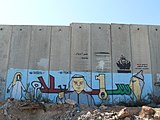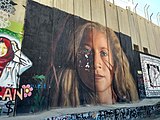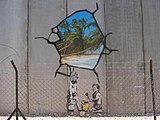West Bank Wall graffiti art

West Bank Wall graffiti art is street art on the walled sections of the Israeli West Bank barrier,[1][2] by a wide range of international and Palestinian artists. The wall is 8 to 10 metres (26 to 33 ft) tall, and is easily accessible to artists as it frequently divides urban areas. The graffiti is on the Palestinian side of the wall and primarily expresses anti-wall sentiments.[3][4]
Description of the graffiti
[edit]The walled section of the Israeli West Bank barrier, known as the West Bank Wall, is 8 to 10 metres (26 to 33 ft) tall, providing artists a large, blank canvas.[5] The graffiti is on the Palestinian side of the wall and primarily expresses anti-wall sentiments.[3]
The graffiti, written in both English and Arabic, includes "flags and fists, slogans and insults, statements of pain and loss", serving as a "visual testimony" to the suffering of Palestinians under the Israeli occupation of the West Bank.[6] The diversity and amount of street art has been described as "initially overwhelming" with "layers upon layers of street art on the Wall" after almost two decades.[5] Most of the graffiti consists of amateur tags without decorations.[5]
In 2017, prevalent text on the wall included "Palestine", "Free Palestine", "Peace", "Love", "Justice", "Hope", "Freedom", "Unity", "Solidarity", "Friendship", "Apartheid Wall", "God is Love", "God Bless Palestine", "Jesus Loves You", John 3:16, "Christmas", and criticism of US presidents and the names of visitors and their countries.[5]
Tourism and reception
[edit]The graffiti has become a tourist attraction, particularly around the Bethlehem area,[7] epitomised by The Walled Off Hotel by graffiti artist Banksy. During Banksy's 2005 trip to the West Bank, a Palestinian man acknowledged both the beauty and irony of Banksy's work, telling him: "We don't want this wall to be beautiful. We hate it. Go home."[6]
Artists
[edit]Similar to Berlin Wall graffiti art, much of the artwork is unclaimed by artists and remains anonymous. In 2005, Banksy became the first major international artist to add graffiti to the wall;[3] his stencilled Flying Balloon Girl was considered to serve as a form of "transnational and experiential empathy".[6]
Banksy was followed by many others, including Blu, Ericailcane, FAILE, JR, Know Hope, Paul Insect, Ron English, Sam3, Swoon and Lushsux.[3]
List of known graffiti artists
[edit]- Banksy
- FAILE
- Ron English
- Jonathan Kis-Lev
- Blu
- Ericailcane
- JR
- Know Hope
- Paul Insect
- Sam3
- Swoon
- Lushsux
Gallery
[edit]-
Banksy's angels, Bethlehem
-
A Banksy, and a mural of Gandhi, Qalandia
-
A mural of Palestinian poet Mahmoud Darwish
-
Graffiti near Ni'lin, referencing the Fourth Geneva Convention
-
Mural of the word Palestine, showing the Palestinian keys
-
Mural of two IDF soldiers aiming at a Palestinian woman
-
We can't live so we are waiting for death
-
Ahed Tamimi mural
-
Art depicting slain journalist Shireen Abu Akleh and a quote from Nelson Mandela ("But we know too well that our freedom is incomplete without the freedom of the Palestinians"), Bethlehem, 2022
-
Three murals from 2007: (1) Ron English: Grade School Guernica; (2) FAILE: Jake LaMotta and Sugar Ray Robinson boxing (from Raging Bull): (3) Ron English: You are not in Disneyland anymore
-
Mural of Rouzan al-Najjar
-
The Peace Kids mural
-
Mural of Leila Khaled, Bethlehem
-
Banksy's Boys with a Sand Bucket, near Bethlehem
-
Boy piercing the watchtower, Bethlehem
-
Lushsux murals
-
Palestinian take on Liberty Leading the People
-
Banksy's A Window on the West Bank (2005), since overpainted with bricks
See also
[edit]References
[edit]- ^ Leuenberger, Christine (2009-06-10). "PIJ.ORG: The West Bank Wall as Canvas: Art and Graffiti in Palestine/Israel By Christine Leuenberger". PIJ.ORG. Retrieved 2022-05-27.
By using the term "barrier," I adhere to journalistic conventions of avoiding terms favored by one or the other side in a conflict... However, when describing sections of the barrier that are either concrete or fenced, I will use "wall" or "fence" in order to provide the most exact physical description.
- ^ Eidelman, Ronen (2011-01-01). "The Separation Wall in Palestine: Artists Love to Hate It". Cultural Activism. pp. 95–114. doi:10.1163/9789042029828_006. ISBN 9789042029811. Retrieved 2022-05-27.
The common Neutral name is the "separation barrier" and the words fence or wall are used according to the location one is referring to
{{cite book}}:|website=ignored (help) - ^ a b c d Krohn, Z.; Lagerweij, J. (2010). Concrete Messages: Street Art on the Israeli-Palestinian Separation Barrier. Scb Distributors. ISBN 978-91-85639-38-0. Retrieved 2022-05-15.
- ^ Ross, J.I. (2016). Routledge Handbook of Graffiti and Street Art. Routledge International Handbooks. Taylor & Francis. p. 635. ISBN 978-1-317-64585-6. Retrieved 2022-05-15.
- ^ a b c d Natalie Amador Solis: Street Art in Israel and Palestine: The Significance of Art on the Streets of Jerusalem, Tel Aviv, and Bethlehem, Photograph Catalog
- ^ a b c Ball, Anna (2013). "Impossible Intimacies: Towards a Visual Politics of "Touch" at the Israeli-Palestinian Border". In A. Valassopoulos (ed.). Arab Cultural Studies: History, Politics and the Popular. Taylor & Francis. pp. 71–72. ISBN 978-1-317-98105-3. Retrieved 2022-05-15.
- ^ Parry, W. (2011). Against the Wall: The Art of Resistance in Palestine. Chicago Review Press, Incorporated. ISBN 978-1-56976-858-7. Retrieved 2022-05-15.
Bibliography
[edit]- Lennon, J. (2022). Conflict Graffiti: From Revolution to Gentrification. University of Chicago Press. ISBN 978-0-226-81567-1. Retrieved 2022-05-15.
- Davies, Dominic (2017-08-18). ""Walls of Freedom": Street Art and Structural Violence in the Global City". Rupkatha Journal on Interdisciplinary Studies in Humanities. 9 (2). Aesthetics Media Services. doi:10.21659/rupkatha.v9n2.02. ISSN 0975-2935.
- Larkin, Craig. “JERUSALEM’S SEPARATION WALL AND GLOBAL MESSAGE BOARD: GRAFFITI, MURALS, AND THE ART OF SUMUD.” The Arab Studies Journal, vol. 22, no. 1, 2014, pp. 134–69, http://www.jstor.org/stable/24877902. Accessed 15 May 2022.























